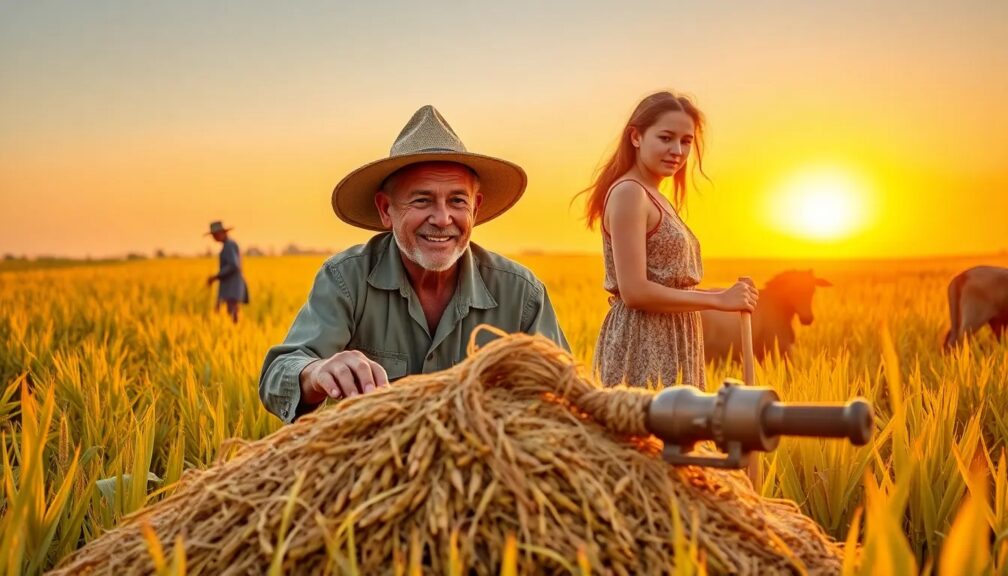What are the traditional tools used for harvesting

Welcome to Our Comprehensive Guide on Traditional Harvesting Tools
As the seasons change and crops reach their peak, farmers turn to the age-old practice of harvesting, a crucial step in the cycle of agriculture. While modern machinery has streamlined many farming processes, traditional tools for harvesting have stood the test of time, offering a glimpse into the rich history and cultural practices of agriculture across the world. In this article, we delve into the variety of traditional harvesting tools that have been utilized by generations of farmers. From the sharp, curved blade of the scythe to the simple, yet effective design of the sickle, these implements are not only functional but also symbolize the human connection to the land. Join us as we explore the craftsmanship behind these tools and how they have been used to gather crops, ensuring sustenance and continuity of traditions.
What is the traditional tool used for harvesting?
Imagine standing amidst a sea of golden wheat, the sun casting its warm glow over the horizon. You can almost feel the texture of the grain and the weight of history in your hands. For centuries, farmers across the globe have relied on a simple, yet profound tool to reap the bounty of their fields. This instrument, unchanged by the passage of time, is as iconic as it is indispensable to traditional agriculture.
Steeped in tradition, the scythe emerges as the protagonist of this age-old tale. Picture the rhythmic motion, the precise yet graceful swings that lay the crop low, ready for gathering. It is an art form passed down through generations, a symphony of man and nature working in unison that modern machinery can scarcely replicate.
The scythe's design—a long, curved blade fixed to a wooden handle called a snath—has withstood the test of time, a testament to the ingenuity of our ancestors. But don't be fooled by its simplicity; mastering the scythe requires skill and endurance, qualities that the modern world often overlooks.
Yet, the story doesn't end here. Beyond the scythe, there are other tools, each with its own rich history and cultural significance. There's the sickle, the scythe's smaller cousin, which offers a more intimate connection with the earth, demanding the harvester to work at the very heart of the crop.
You might wonder why these ancient tools still capture our imagination in an era of high-powered combine harvesters and drones. The answer lies not just in the nostalgia of bygone days but in the resurgence of sustainable farming practices. Today, a new wave of farmers is rediscovering these tools, favoring them for their environmental friendliness and the unparalleled quality they bring to the harvest.
So, what might seem like a simple question about traditional harvesting tools opens the door to a world where the past and future of agriculture converge. A world where every swing of the scythe tells a story of humanity's connection to the land. The question beckons you to delve deeper into this legacy, to explore the roots of our sustenance, and perhaps, to even pick up a scythe and join the dance of harvest. The journey is rich, the knowledge vast, and the experience, truly transformative.
Which tool is used to harvest?
Discover the secrets behind the ancient art of harvesting – a practice that dates back to the dawn of agriculture, where the choice of tool could mean the difference between abundance and scarcity. If you've ever felt the allure of self-sufficiency or marveled at the sheer breadth of human ingenuity, then the revelation of these tools will grip your imagination.
Imagine standing amidst a golden field, the sun casting its warm glow on your face. In your hands, you hold the key to unlocking the earth's bounty. But what is this key? The answer lies in a diverse array of implements, each designed for a specific crop and purpose. From the scythe that swings with a rhythmic grace to the precision of the combine harvester, these tools have evolved alongside humanity, a testament to our enduring relationship with the land.
- Scythes - A time-honored traditional blade that sweeps through stalks with elegance, it has fed civilizations for millennia.
- Sickles - With a crescent moon shape, this tool is a symbol of efficiency in small-scale farming.
- Combine Harvesters - Behemoths of modern agriculture, these machines are the pinnacle of harvesting technology.
But wait, there's more. The journey from seed to harvest is filled with a plethora of specialized tools that not only make the process more efficient but also carry the whispers of history and culture within their design. Whether it's the flail used to thresh wheat or the grape harvester shaking vines under the Tuscan sun, each tool has a story to tell.
Are you intrigued by how these tools have shaped the course of human history, or perhaps you're considering taking the leap into your own farming adventures? Dive deeper into the world of harvesting tools and uncover the rich tapestry of knowledge that awaits. The land calls out for those willing to listen and learn – will you be one of them? The next chapter of agriculture could be in your hands.
What tools do you need to harvest?
Imagine standing amidst a sea of ripe, luscious produce, the air sweet with the promise of bounty. The thrill of harvesting your own food is unparalleled. But wait, are you equipped with the right equipment to turn this vision into reality?
First on your list should be a reliable pair of gardening gloves. They are your first line of defense against thorns, splinters, and dirt. Protect your hands, and you'll be able to harvest tirelessly.
Next, consider a harvesting basket or container. Whether you're collecting delicate berries or hefty vegetables, having something to safely transport your produce is vital. Choose one that's comfortable to carry and easy to clean.
A pruning shear or scissors is crucial for snipping herbs and cutting flowers. It's a simple tool, but choosing one with the right grip and sharpness can make all the difference in precision and effort.
Are you dealing with tree fruits? You'll regret not having a fruit picker. This tool saves you the risk of climbing rickety ladders and ensures your fruit is plucked at the peak of perfection.
For root vegetables, a harvesting fork or a spade is indispensable. They can help you unearth potatoes, carrots, and beets without damaging the precious produce beneath the soil.
Don't overlook the importance of a utility knife. From cutting twine to opening bags of soil, its versatility is a game-changer.
Perhaps you are imagining a typical harvest, but the secret tool that many forget is a moisture meter. Knowing the right time to harvest is just as critical as how you harvest. This device ensures you're not picking too early or too late.
But tools are only part of the story. The real secret lies in how you use them, and that's where the true excitement begins. Imagine the satisfaction as you slice through the stem of a ripe tomato or unearth a vibrant carrot. The crunch, the fragrance, the flavors...this is just a glimpse of what awaits you.
Remember, the right tools not only make the work easier; they elevate the experience, turning labor into pleasure, and effort into reward. Don't let another season pass by without feeling the joy of harvest in your own hands. The question isn't just what tools you need, but what moments you'll create with them. The anticipation of discovery, the pride of self-sufficiency, the connection to nature—these are the true fruits of your labor.
Ready to dive in? Your garden awaits, and the time is ripe for the picking.
What tools do traditional farmers often use for planting and harvesting?
Dive deep into the rich tapestry of agricultural history and you'll discover a fascinating array of tools and implements that have long been the backbone of traditional farming practices. These tools, often passed down through generations, are not mere artifacts; they are a testament to the ingenuity and resourcefulness of those who work the land.
From the simple, time-honored handheld hoe to the more complex, yet equally traditional, horse-drawn plough, each tool has played a pivotal role in the sowing and reaping of crops. The sickle and scythe, for example, have been farmer favorites for centuries, slicing through stalks with precision and speed that defies their primitive appearance.
But these tools aren’t just static pieces of history; they are living legends in the agricultural world. The sheer resilience and enduring design of these implements allow farmers to continue producing food in ways that have sustained humanity for ages.
Imagine the scene: the sun rising over a dew-kissed field, the earthy smell of soil ripe for planting, and in the hands of the farmer, a seed drill that precisely disburses seeds into the ground, as it has done for countless seasons. As harvest time approaches, the winnowing basket comes into play, a simple yet ingenious device for separating grain from chaff.
If you're captivated by the romance and tradition of old-school farming, there's more to explore. These tools tell a story of survival, of a time when human hands and natural elements worked in harmony. And the best part? The knowledge and skills required to use these tools are still very much alive, passed on like a sacred rite of passage from one generation of farmers to the next.
Stay tuned and delve into the world of traditional farming tools—an ode to the past, a gift to the future, and an enduring legacy of agricultural prowess.
What are the traditional tools used for harvesting agriculture
Dive into a world where the rustic charm of manual labor marries the rhythmic beauty of time-honored practices. As you stand on the brink of discovery, the secrets of traditional harvesting beckon, promising a journey through the annals of agricultural history, a realm where every tool tells a tale of earth and toil.
Imagine the feel of a sturdy wooden handle in your grasp, the weight of history in your hands. Picture the sharp, clean slice of a sickle as it arcs through the air, the whisper of wheat stalks falling in hushed reverence to the ground. Can you hear the steady thud of a flail as it threshes golden grains, separating the wheat from the chaff?
1. Scythe: A symbol of agricultural heritage, the scythe's elegant blade has been the dance partner of farmers for centuries, enabling them to cut crops efficiently at speed.
2. Winnowing Basket: A testament to simplicity, this lightweight vessel has deftly separated grain from husk with the help of nothing but the wind.
3. Spade: Unchanged in its basic design over millennia, the spade has turned the soil over and over, ushering in each new cycle of growth.
But wait, there's more to this narrative than mere implements. The knowledge of when and how to wield these tools is an art passed down through generations, a living, breathing chronicle of agricultural prowess. The timing of the harvest, the angle of the cut, the intensity of the thresh—all nuances that define the mastery of the craft.
Could you be the one to carry forward these traditions? Can you feel the pull of the past as it intertwines with the potential of the future? The journey through the world of traditional harvesting tools is not merely one of curiosity—it's a voyage of personal discovery, a chance to connect with the age-old dance of the harvest.
There is a treasure trove of wisdom waiting to be unlocked. As the sun dips below the horizon, casting long shadows of the tools upon the fertile earth, one can't help but feel a part of something larger than life.
The true essence of these tools lies not just in their physical form, but in the spirit they imbibe—a spirit of resilience, ingenuity, and harmony with nature. To wield them is to engage in a legacy of sustainability that predates modern machinery.
To continue peeling back the layers of this rich tapestry, to immerse oneself in the lore and legacy of traditional harvesting tools, is to affirm a commitment to the timeless dance of agriculture. Don't let this knowledge slip through your fingers like grains in the winnowing basket—embrace it, and become part of the story that has fed civilizations for millennia.
Consejo final: If you're interested in the traditional tools used for harvesting, it's worthwhile to engage with local farming communities or agricultural museums to see these tools firsthand. Hands-on experience can provide invaluable insights into the heritage and methods of agriculture. Keep nurturing your curiosity; there is much to learn from the past that can inform sustainable practices for the future. Wishing you an enriching journey in exploring the roots of agriculture. Take care and may your quest for knowledge be fruitful.
 What is the best tool to harvest vegetables
What is the best tool to harvest vegetables What is a modern tool used for harvesting
What is a modern tool used for harvesting What do you use to harvest vegetables
What do you use to harvest vegetables Is hand pulling weeds a waste of time
Is hand pulling weeds a waste of time Can you get rid of weeds without pulling them
Can you get rid of weeds without pulling themIf you want to know more about similar articles like What are the traditional tools used for harvesting you can visit category Gardening Tools.
Deja una respuesta